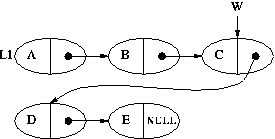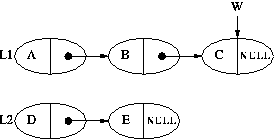

3. Our Specification Of Lists - Details

With the specification of collection complete, let's turn to lists.
Our specification of List is a small extension of Collection, taking
into account the 2 special properties lists have that ordinary
collections don't, namely (refer to handout):
- in a list there is a linear order (called followed by,
or next) defined on the elements: every element (except
for one, called the last element) is followed by one
other element, and no two elements are followed by the same
element. There is exactly one element in a list (the first
element) that does not follow after any element.
- It is possible to access individual elements of a list. This
access is provided by having a window on the list; when
we define the abstract type List we will also have to
define Window.
The implications of list is a special kind of collection are
two-fold:
- Any operation that is applicable to a collection is applicable
to a list. A list is a collection.
- However, lists are special kinds of collections - they have 2
special properties. We have to add extra postconditions to the
operators in order to say how these properties are affected by
the operations.
- INSERT:
- if C is a list: V is the first element in C'.
- DELETE:
- if C is a list: it is the first occurrence of V in C
that is deleted.
- JOIN:
- if C1 and C2 are both lists: in C1' the elements of C1
and C2 are in their original order, and the elements of C1 are
before the elements of C2.
- MAP:
- if C is a list: if E1 occurs before E2 in C, then the call P(E1)
is made before the call P(E2).
To complete our specification we just have to specify what a window
is, how windows are affected by the above list operations, and what
operations can be performed on windows,
A window is always associated with an individual element of a list;
there is no concept of an empty window, or of a window that
gives access to several elements. We say that the window is on
the element. A window allows us only to look at an element, not to
change it.
Unlike the textbook definition we do not specify how many windows
there will be for a given list. There could be none, there could be
many.
A window is not to be confused with a list element. An element
exists whether or not there is a window on it; if we have a window on
an element and then we move or destroy the window, the element is
unaffected. There can be several distinct windows all on the
same element at the same time.
Of course, you shouldn't confuse windows with pointers in C. Window
is an abstract type, which we are in the process of specifying. It
might be possible to implement this abstract type with C pointers, but
it might not; and even if it is possible, it may not be the best way
to implement the abstract type. The question of how to implement
windows is a separate issue from defining what a window is.
How are windows affected by the list operations? For example, if we
create a window on the first element of L and then insert a new value
into L, is the window now on the new first element, or does
it stay attached to the element it was on before the insert? Our
general answer is: if a window is on element E then it stays on
element E unless explicitly moved. E.g., when we JOIN two lists, the
windows all stay on their elements.
The operations on windows are specified in the
handout:
- CREATE_WINDOW

-
- input: L (a list), W (a window).
- output: W'.
- preconditions: L is not empty, W is undefined.
- postconditions: W' is on the first element in L. Storage
is allocated as needed.
- DESTROY_WINDOW
-
- input: W (a window).
- output: W'.
- preconditions: none.
- postconditions: W' is undefined. As much space is
reclaimed as is possible.
Destroying a window does not affect the element or list that the
window was on. But what about the opposite? Suppose we have a
window on element E in list L and we delete E, or destroy L.
What happens to the window? This is an important part of the
specification. The 2 main possibilities are:
- when an element is deleted, or a list destroyed, all the
associated windows are destroyed automatically.
- deleting an element or destroying a list causes the
associated windows to become invalid but the
space they consume remains allocated.
Option (1) is the better choice, but it is also the harder
to implement: it requires every list element to keep track of
all the windows that are on it. This is not difficult, but for
simplicity's sake, we will take option (2). What this means is
that the user is responsible for destroying the windows he
creates, and for keeping track of whether a window is valid
or not.
- IS_LAST
-
- input: W (a window).
- output: boolean.
- preconditions: W is defined.
- postconditions: true if W is on the last element in a
list, false otherwise.
- GET_VALUE
-
- input: W (a window).
- output: V (a value of a list element).
- preconditions: W is defined.
- postconditions: V is the value of the element W is on.
- MOVE_FORWARD

-
- input: W (a window).
- output: W'.
- preconditions: W is not on the last element of a list.
- postconditions: W' is on the element that follows the
element W was on.
This is the only operation the moves a window. There are other
useful ones we could have included - MOVE_BACKWARD, for example.
- SPLIT
-
- input: L1, L2 (lists), W (a window).
- output: L1' and L2'.
- preconditions: W is a window into L1, L2 is undefined.
- postconditions: L2' = the elements of L1 following the one
W is on, their order unchanged. If W is on the last
element, L2' is empty. L1' = the elements of L1 up to and
including the one W is on, their order unchanged.

Example of SPLIT:

SPLIT(L1,L2,W) would produce:

What about other windows that might be on elements of L1?
Following our general rule, SPLIT does not affect them: they are
on the same elements after SPLIT as they were before.
We are now finished the specification phase of our design for
the abstract data types collection and list. The next design phase
addresses the implementation of the datatype. This is a design
process, too, and it is concerned almost exclusively concerned with
the type definitions:
- will something be a record, or an array, or a linked data
structure?
- how many pointers will there be, where should they point?
- etc...
We will not consider in any detail the code that implements
the operations. The reason is this: once the C type definitions have
been decided upon, the code for the operations is completely
determined - the specification tells us what they must do, and the
type definitions tell us on what specific data objects they must
operate. Filling in the code requires no further decisions, just
careful attention to detail. So you see the decisions about the type
definitions are very important - it is they determine how simple and
efficient our code will be.




